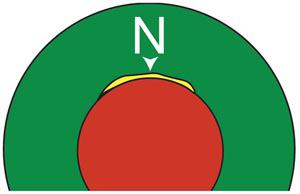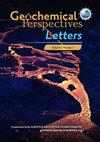作为地球最下层地幔主要氮库的菱镁矿
IF 3.7
1区 地球科学
Q1 GEOCHEMISTRY & GEOPHYSICS
引用次数: 0
摘要
铁闪长岩(Mg,Fe)O 是继桥粒岩之后下地幔中含量最高的相。地核-地幔边界上方的超低速度区可能含有非常丰富的铁镁锰矿(Fe,Mg)O,这可能是基底岩浆洋分化结晶的结果。我们通过实验研究了氮在铁闪长岩-镁闪长岩固溶体系列中的溶解度与铁含量的函数关系。我们在 20-33 GPa 和 1600-1800 °C 温度条件下,在与金属铁平衡的状态下进行了多安培实验。氮的溶解度从富含镁的铁绿泥石的几十ppm(μg/g)增加到近乎纯净的绿泥石的超过10 wt.%。如此高的溶解度似乎是由于与 NiAs 型 FeN 的固溶所致。我们的数据表明,在岩浆海的碎裂结晶过程中,岩芯-地幔边界的氮含量会变得非常丰富,因此今天的深地幔可能是地球上最大的氮库。人们经常讨论的大块硅酸盐地球的 "亚软岩氮/碳 "比率可能是对这一深层储藏取样不足的一个假象。本文章由计算机程序翻译,如有差异,请以英文原文为准。

Magnesiowüstite as a major nitrogen reservoir in Earth’s lowermost mantle
Ferropericlase (Mg,Fe)O is after bridgmanite the most abundant phase in the lower mantle. The ultralow velocity zones above the core-mantle boundary may contain very Fe-rich magnesiowüstite (Fe,Mg)O, possibly as result of the fractional crystallisation of a basal magma ocean. We have experimentally studied the solubility of nitrogen in the ferropericlase-magnesiowüstite solid solution series as function of iron content. Multi-anvil experiments were performed at 20–33 GPa and 1600–1800 °C in equilibrium with Fe metal. Nitrogen solubility increases from a few tens ppm (μg/g) for Mg-rich ferropericlase to more than 10 wt. % for nearly pure wüstite. Such high solubilities appear to be due to solid solution with NiAs-type FeN. Our data suggest that during fractional crystallisation of a magma ocean, the core-mantle boundary would have become extremely enriched with nitrogen, such that the deep mantle today could be the largest nitrogen reservoir on Earth. The often discussed “subchondritic N/C” ratio of the bulk silicate Earth may be an artefact of insufficient sampling of this deep reservoir.
求助全文
通过发布文献求助,成功后即可免费获取论文全文。
去求助
来源期刊

Geochemical Perspectives Letters
Earth and Planetary Sciences-Geochemistry and Petrology
CiteScore
7.00
自引率
2.00%
发文量
42
审稿时长
15 weeks
期刊介绍:
Geochemical Perspectives Letters is an open access, internationally peer-reviewed journal of the European Association of Geochemistry (EAG) that publishes short, highest-quality articles spanning geochemical sciences. The journal aims at rapid publication of the most novel research in geochemistry with a focus on outstanding quality, international importance, originality, and stimulating new developments across the vast array of geochemical disciplines.
 求助内容:
求助内容: 应助结果提醒方式:
应助结果提醒方式:


